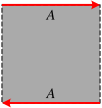
Back Reálná projektivní rovina Czech Πραγματικό προβολικό επίπεδο Greek Reela projekcia ebeno Esperanto Plano proyectivo real Spanish Reaalinen projektiivinen taso Finnish Plan projectif réel French Reëel projectief vlak Dutch Płaszczyzna rzutowa rzeczywista Polish Вещественная проективная плоскость Russian Realna projektivna ravnina Slovenian
 The fundamental polygon of the projective plane. |
 The Möbius strip with a single edge, can be closed into a projective plane by gluing opposite open edges together.
|
 In comparison, the Klein bottle is a Möbius strip closed into a cylinder. |
In mathematics, the real projective plane is an example of a compact non-orientable two-dimensional manifold; in other words, a one-sided surface. It cannot be embedded in standard three-dimensional space without intersecting itself. It has basic applications to geometry, since the common construction of the real projective plane is as the space of lines in R3 passing through the origin. The real projective plane is then an extension of the (ordinary) plane — to every point (v1,v2) of the ordinary plane, the line spanned by (v1,v2,1) is associated (i.e., the real projective plane is the projective completion of the ordinary plane, cf. also the homogeneous coordinates below) while there are also some “points in the infinity”.
The real projective plane is also often described topologically, in terms of a construction based on the Möbius strip: if one could glue the (single) edge of the Möbius strip to itself in the correct direction, one would obtain the projective plane. (This cannot be done in three-dimensional space without the surface intersecting itself.) Equivalently, gluing a disk along the boundary of the Möbius strip gives the projective plane. Topologically, it has Euler characteristic 1, hence a demigenus (non-orientable genus, Euler genus) of 1.
Since the Möbius strip, in turn, can be constructed from a square by gluing two of its sides together with a half-twist, the real projective plane can thus be represented as a unit square (that is, [0, 1] × [0,1]) with its sides identified by the following equivalence relations:
- (0, y) ~ (1, 1 − y) for 0 ≤ y ≤ 1
and
- (x, 0) ~ (1 − x, 1) for 0 ≤ x ≤ 1,
as in the leftmost diagram shown here.
© MMXXIII Rich X Search. We shall prevail. All rights reserved. Rich X Search